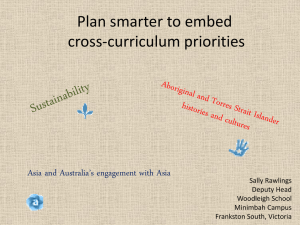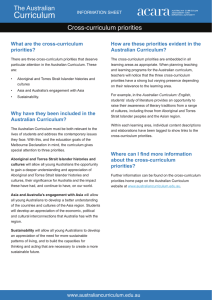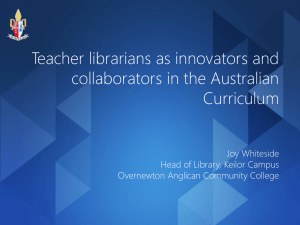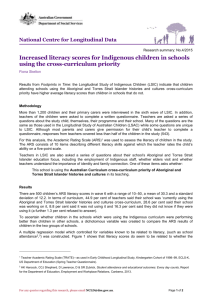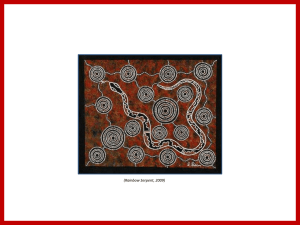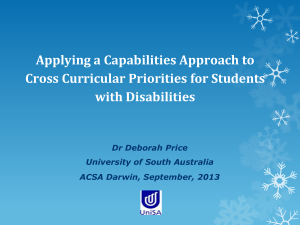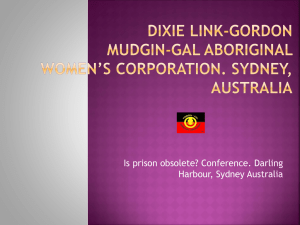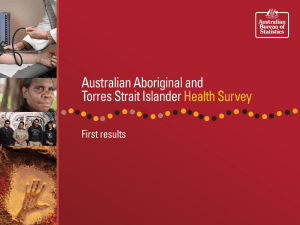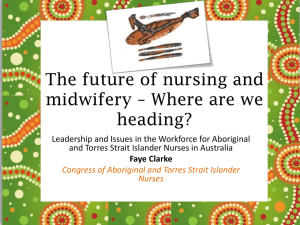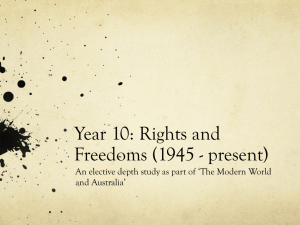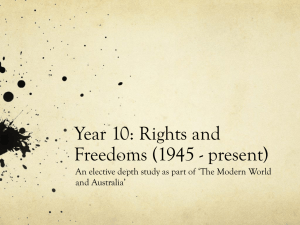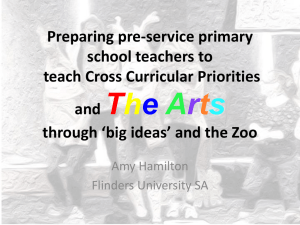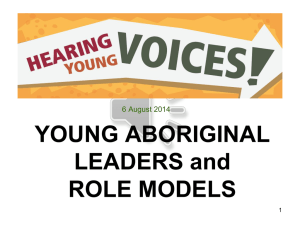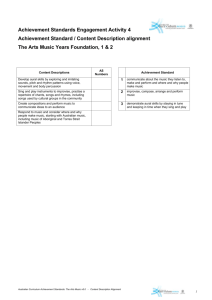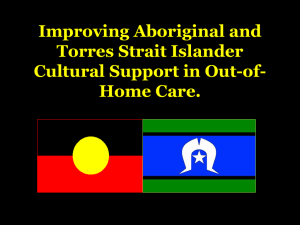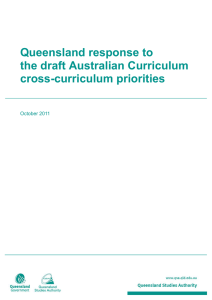PowerPoint - Australian Curriculum Studies Association
advertisement
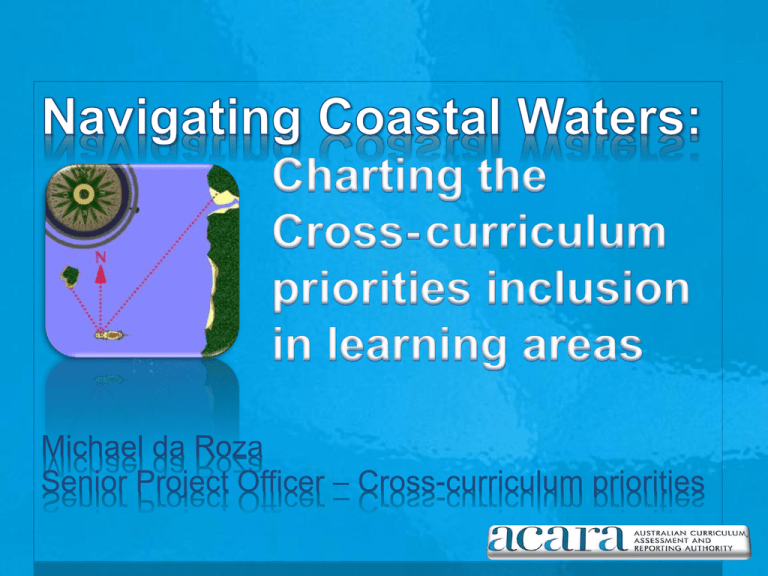
The Australian Curriculum A three dimensional curriculum Three Cross-curriculum priorities Three key concepts Country / Place Culture People Three key concepts Asia and its diversity Achievements and contributions of the peoples of Asia Asia-Australia engagement Three key concepts Systems World Views Futures Views of the curriculum traditional , back to basics discovery, curiosity forced , imposed rescue, support package, contained new, enterprising “The real voyage of discovery consists not in seeking new landscapes, but in having new eyes” Marcel Proust 1871-1922 Engaging with the priorities cold to the idea challenges open to change engaged create a false appearance of inclusiveness Tokenism: toAwareness Placing the priorities Who ? How? Where ? Priority consultation: Who? Learning Areas Critical friends Subjects CCP Advice Subject Writers & Advisors Priority process: How ? 1 2 3 4 • The Melbourne Declaration • AC - Priority introductory text • AC - Priority organising idea text • AC - Learning Area statements • AC – Content description and elaboration text Priority inclusion: Where? Priority mapping: the statement Paragraph 1: What the priority provides the learning area Paragraph 2: What the learning area provides the priority Paragraph 3: What the priority provides students with in the learning area Priority mapping: the statement Paragraph 1: What the priority provides the learning area In the Australian Curriculum: History, the priority of sustainability provides a context for developing students’ historical knowledge, understanding and skills. It assists students in understanding the forces that influence continuity and change. Priority mapping: the statement Paragraph 2: What the learning area provides the priority The Australian Curriculum: History provides content that • supports the development of students’ world views, • judgments about past…access to and use of the Earth’s resources. • decisions about sustainability to help shape a better future. Priority mapping: the statement Paragraph 3: What the priority provides students with in History In this learning area, students develop understanding… of • the changes in environments over time, • the role played by individuals and communities in protecting environments, • the emergence of farming and settled communities, • the development of the Industrial Revolution and the growth of population, • the overuse of natural resources • the rise of environmental movements Priority mapping: process Priority mapping: the tags Sustainability The Cross-curriculum priorities Priority map: tagging Year 2: History Organising Idea 7 (ACHHK045-1)identifying, discussing why a particularwith site Aboriginal has heritage (ACHHK045-2) in consultation and significance/cultural value forand present generations (for example it Torres Strait Islander people, visiting (where appropriate) local provides a record of a significant historical event, has aesthetic sites, places and landscapes of significance to Aboriginal and value, Strait reflects the community’s how it sites, can be cared Torres Islander people (for identity) example and engraving rock for. paintings, natural sites or features such as the Birragai rock shelter, creeks or mountains) and how it can be cared for Actions for a more sustainable future reflect values of care, respect and responsibility, and require us to explore and understand environments Priority map: viewing English Exploring the terminology used in caring for the environment Year 2: English Organising Idea 7 for example, flora, fauna, biodiversity (ACELA1470-2) Exploring the terminology used in caring for the for Science identifying actions at school and home such environment as turning off dripping that biodiversity can conserve resources (ACSSU032-1) example, flora, taps, fauna, (ACELA1470-2) History 2: Science discussing why a particular site has heritage significance/cultural value Year for present generations (for example it provides a record of a significant historical event, has aesthetic value, reflects the identifying actions at school andand home such ascared turning off dripping community’s identity) how it can be for (ACHHK045-1) identifying,resources in consultation with Aboriginal and Torres Strait Islander taps, that can conserve (ACSSU032-1) people, and visiting (where appropriate) local sites, places and Actions for alandscapes more ofsustainable future values significance to Aboriginal andreflect Torres Strait Islander people (for example engraving sites, rock paintings, natural sites or of care, respect and responsibility, and require us to features such as the Birragai rock shelter, creeks or mountains) and explore and how understand environments it can be cared for (ACHHK045-2) Priority map: viewing PRIORITY: SUSTAINABILITY SUBJECT: HISTORY F ALL 1 2 CONTENT CONTENT CONTENT CONTENT CONTENT CONTENT DESCRIPTION ELABORATION DESCRIPTION ELABORATION DESCRIPTION ELABORATION Organising Idea 9 SYSTEMS OI.1 OI.2 OI.3 Sustainable futures result from actions designed to preserve and/or restore the quality and uniqueness of environments WORLD VIEWS OI.4 OI.5 ACHHS052 / 1a ACHHS052 / 1a FUTURES OI.6 OI.7 ACHHK045 ACHHK045 / 1, 2 ACHHK045 ACHHK045 / 1, 2 OI.8 OI.9 OI.9 Priority map: Sequence Organising Idea 7 Geography: 95 The sequencingYear of tagged Geography: 8 Geography: Foundation 10 Geography: Year Year 3 4 Cross-curriculum priority 1 content using the organising ideas aims to ensure The capacity ofthe the world’s environments to sustainably feed the The influence people have on the human characteristics ofvalue places and •Reflect identifying that people have different views about the of The describing reasons why role some of to people’s places are environmental to people, worldviews, and how for they The importance on their learning of environments propose tospecial individual animals and action people, in response and how to a The natural, managed and constructed features of places, their thatmanagement connections are made, maintained and projected future population to achieve food security for the of spaces within them (ACHGK029) particular environments …, and about the nature and extent ofand can example, be looked human-centred after (ACHGK004) and earth-centred, in producing different contemporary they canhow be protected geographical (ACHGK022) issue and identify effects of the location, they change and how they can bethe cared forAustralia (ACHGK005) developed between the priorities and within and World (ACHGK064) •proposal investigating aapproaches current local planning issue, for example, their protection, and how this links to ideas about attitudes discussing and different ways towards of looking environmental after their ‘special management for • •describing recognising (ACHGS025) that therediscussing are different perspectives on what •the local features people look after, for example, aplaces’, bushland, learning areas. ••across examining the effects ofpeople anticipated future population on redevelopment of a environmental site, preservation offinding open space orgrowth subdivision environmental sustainability discussing example, whether their bedroom, classroom change or school isprotect necessarily andwhy deciding athe problem how designing constitutes actions environmental that sustainability couldand take to and considering and improve wetland, park or heritage building, out and how global food production and security, and its implications for of farming land, exploring why people have different views on the • these investigating aperceive significant geomorphic landscape that isthis threatened that they should could be contribute managed to and looking explaining after these people’s places choices ofcare places role of people people in protecting as important the environments that provide features need to be cared for, and who provides agriculture and agricultural innovation issue, andfor developing a or class response toenvironmental it by human activities, and developing a to proposal forthis the future… methods for managing responding changes habitats animals and discussing ways of doing Actions for a more sustainable future reflect values of care, respect and responsibility, and require us to explore and understand environments Priority map: viewing CCP Organising Ideas 1 1 1 2 2 2 3 3 3 4 4 4 5 5 5 6 6 6 7 7 7 8 8 8 9 9 Subjects Phase 1-3 English Math Science History Geography Languages The Arts HPE Technologies Economics &Business Civics& Citizenship Work Studies Year F-10 F-2 3-5 6-8 9-10 Required priority map elements Priority advice 1. What do you regard as the key to meaningful representation of Cross-curriculum priorities in the Australian Curriculum? 2. How can ACARA support you in the meaningful representation of the Cross-curriculum priorities in the Australian Curriculum? 3. How are you engaging with the Crosscurriculum priorities in your educational context? Priority support

